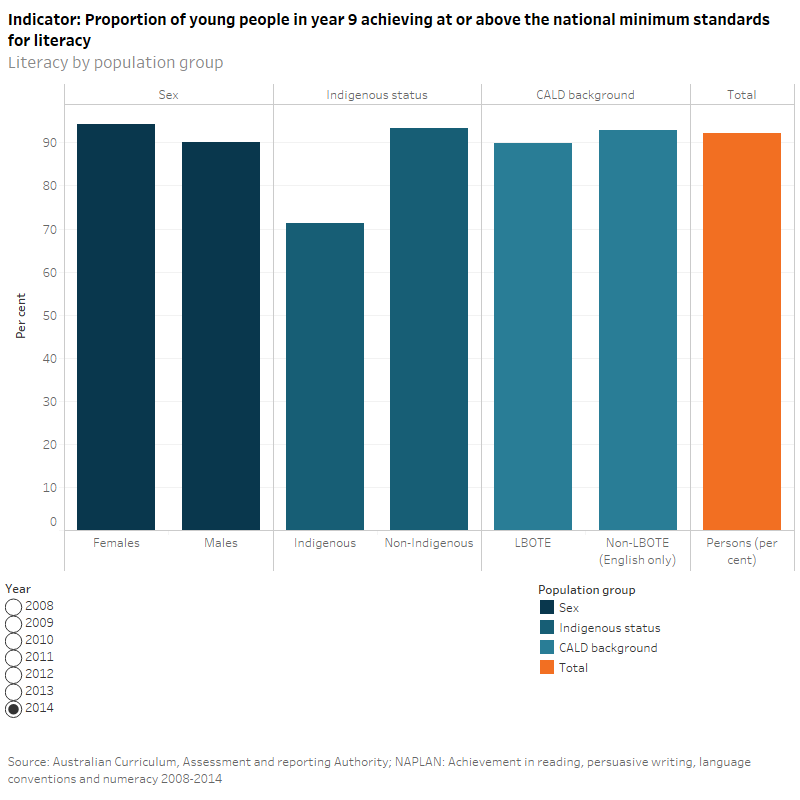Literacy
Why are literacy rates important?
Literacy skills acquired in the primary school years are essential for day-to-day living, further educational attainment, social development and employment.
Literacy is often thought to involve reading, writing and understanding the conventions of language (DECD 2013). While these aspects are very important, they do not cover the entire field of literacy. A broader definition of literacy is defined by OECD as the ability to understand, use and reflect on written texts in order to achieve one’s goals, to develop one’s knowledge and potential, and to participate effectively in society (Schneider et al. 2010).
For the purpose of this indicator, reading is used as the measure for literacy, specifically young people who are achieving at or above the national minimum standards for reading.
Research shows that highly developed literacy capabilities strongly contribute to the social, economic and physical wellbeing of individuals (DECD 2013). A number of factors affect successful educational outcomes during the school years, such as a young person’s home environment (including whether books are available at home and whether parents read aloud to their children), their engagement with the school, the quality of their educational experience and their attitudes to school and learning (Walsh & Black 2009). Several other factors have also been shown to have an impact, such as resources, parental level of education, school engagement, and socioeconomic status (Walsemann et al. 2008).
Do literacy rates vary across population groups?
In 2014, the majority of Year 9 students achieved at or above the national minimum standards for reading (92%). Females were more likely to achieve at or above the minimum standards than males in reading, 94% compared to 90% respectively. Non-Indigenous students were more likely to achieve at or above the minimum standards than Indigenous students (93% and 71% respectively). Students from English-speaking backgrounds were slightly more likely to achieve at or above the minimum standards in reading than those with a Language Background Other Than English (LBOTE) (about 93% and 90%, respectively).
Has there been a change over time?
The proportion of students achieving at or above the national minimum standards for reading has remained relatively steady at 92% between 2008 and 2014. Over the same period, similar trends were observed among males and females (90% and 94%, respectively). The proportion of Indigenous students achieving at or above the national minimum standards was between 64% and 74% for the same time period. The trend for non-Indigenous students between 2008 and 2014 was higher and less variable than for Indigenous students with proportions between 92% and 95%. For students with a LBOTE and non-LBOTE status the percentage of students achieving at or above the national minimum standards for literacy remained steady between 2008 and 2014 (89% and 93%, respectively).

The National Assessment Program – Literacy and Numeracy (NAPLAN) tests are the only Australian assessments that provide nationally comparable data on the performance of students in the vital areas of literacy and numeracy.
CALD refers to Culturally And Linguistically Diverse Background.
LBOTE refers to Language Background Other Than English.
Data quality statement: Not available, please refer to the published source (above) for further information.
DECD (Department for Education and Child Development) 2013. Numeracy and literacy: a numeracy and literacy strategy from birth to 18. Adelaide: Government of South Australia (Department for Education and Child Development).
Schneider, B, Keesler, V, Morlock, L 2010. The effects of family on children’s learning and socialisation, in OECD (2010). The Nature of Learning, OECD Publishing.
Walsemann K, Geronimus A & Gee G 2008. Accumulating disadvantage over the life course: evidence from a longitudinal study investigating the relationship between educational advantage in youth and health in middle age. Research on Aging 30(2):169–99.
Walsh L & Black R 2009. Overcoming the barriers to engagement and equity for all students. Canberra: Foundation for Young Australians.


